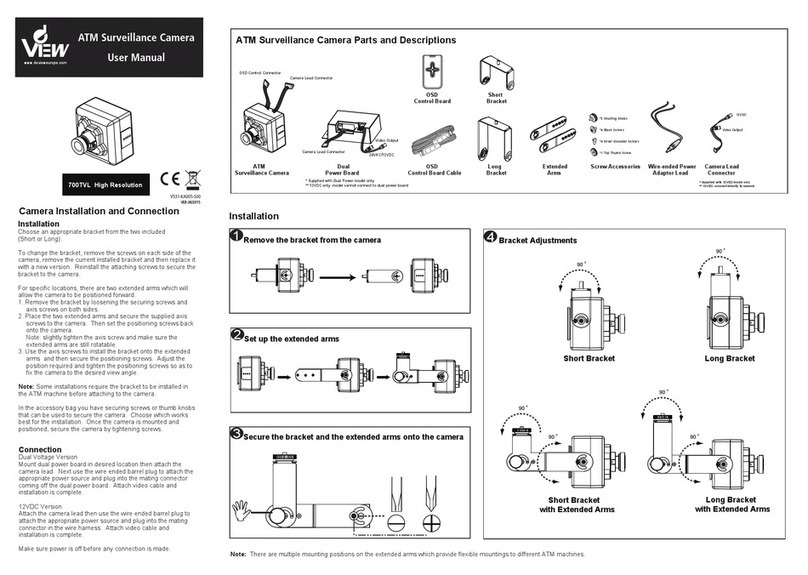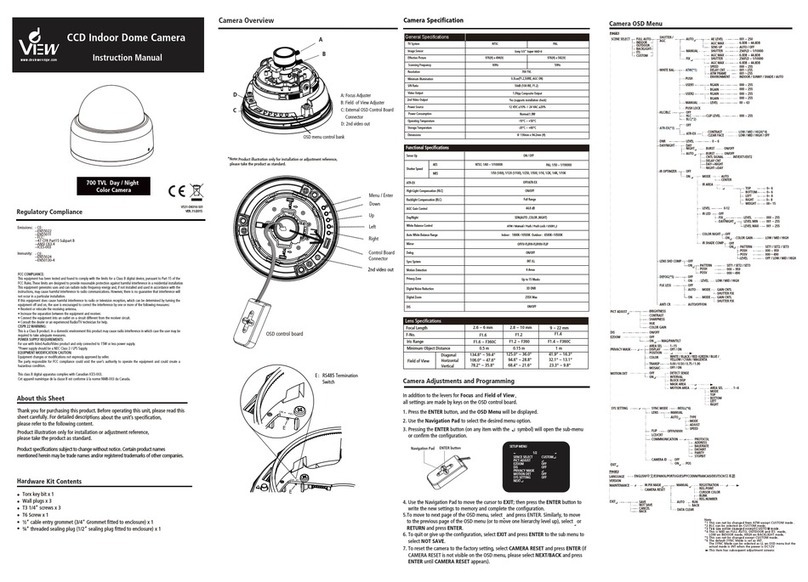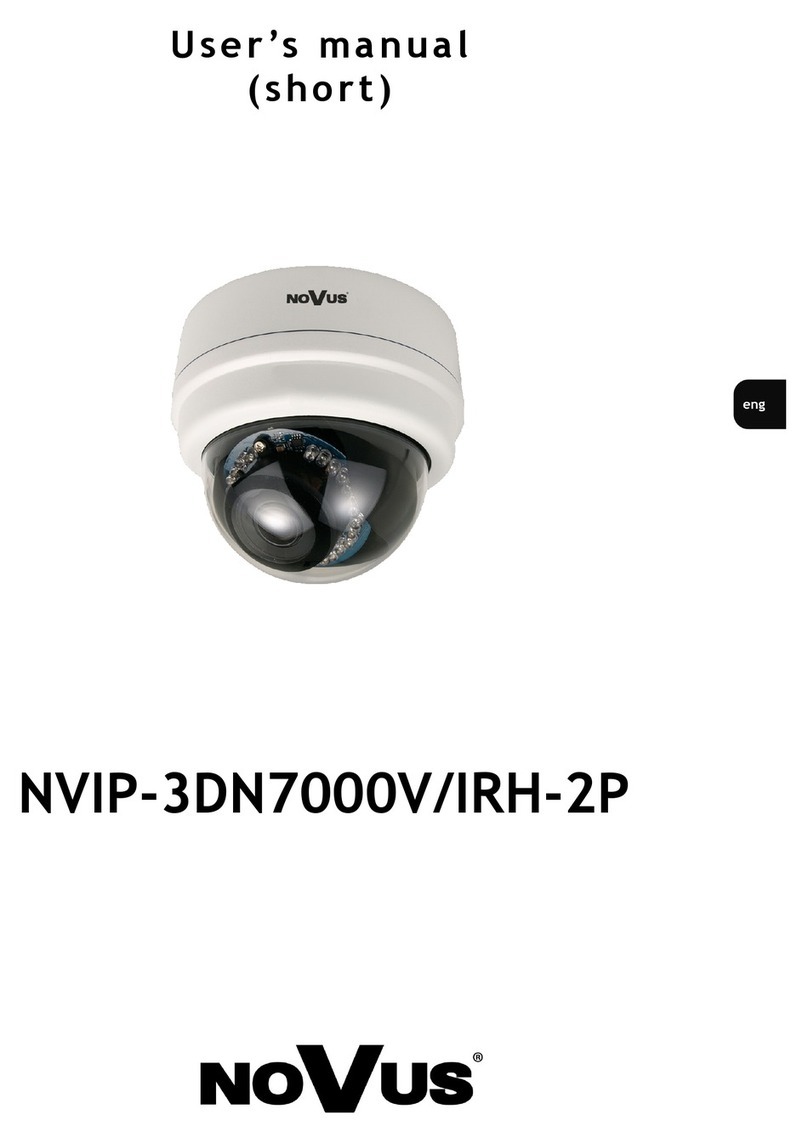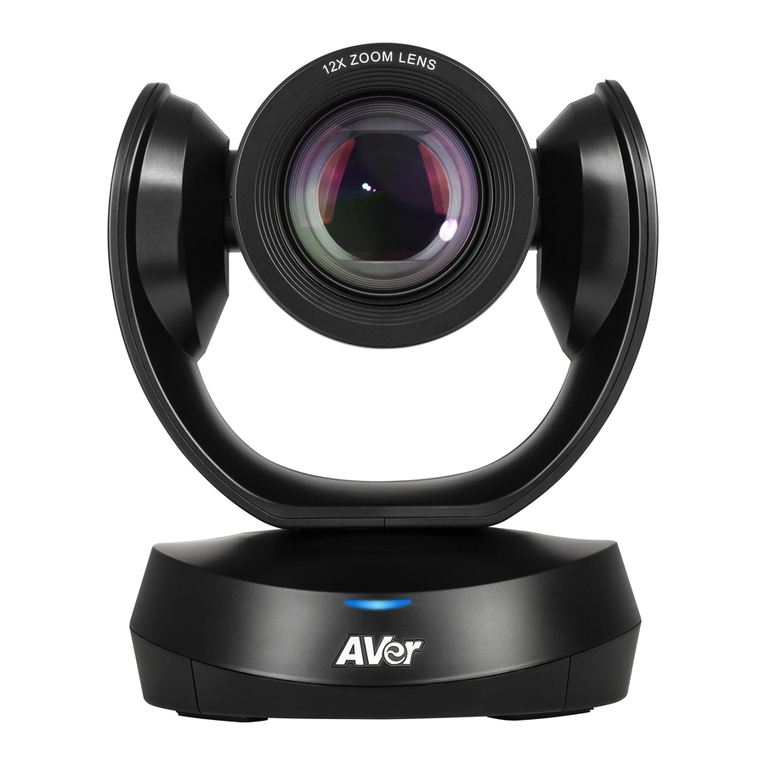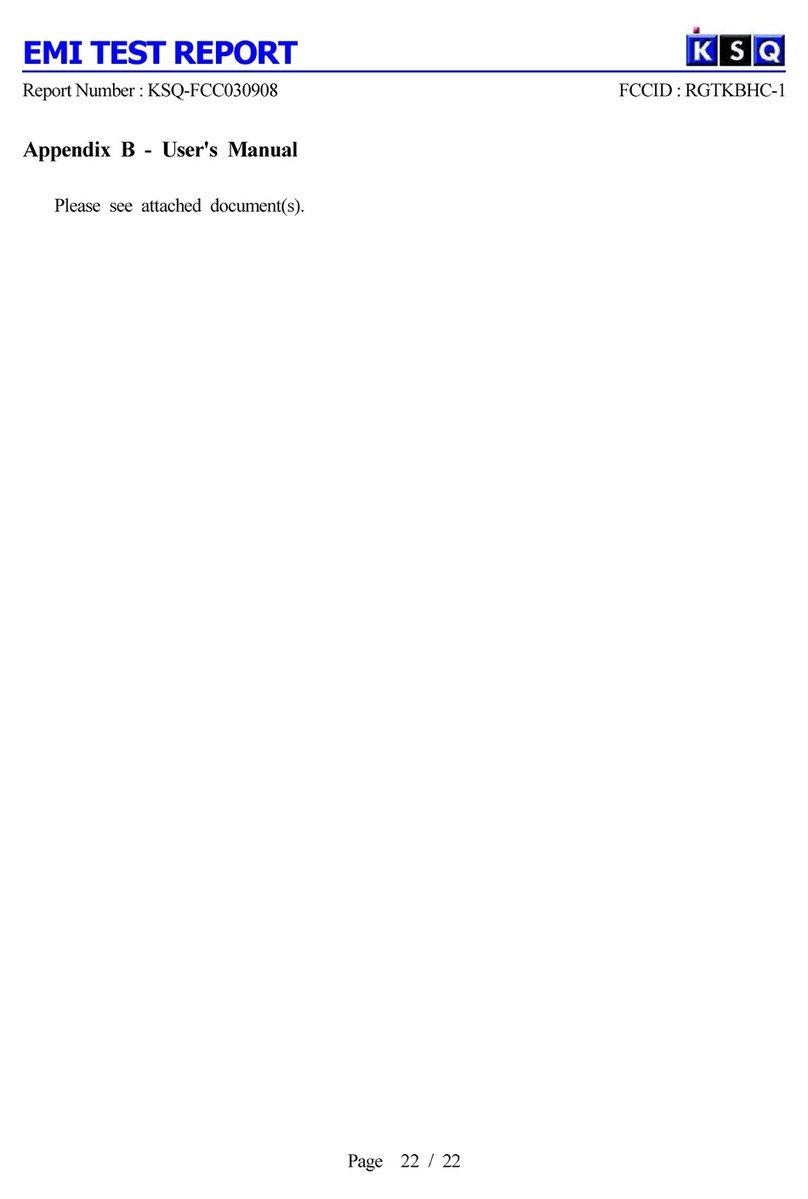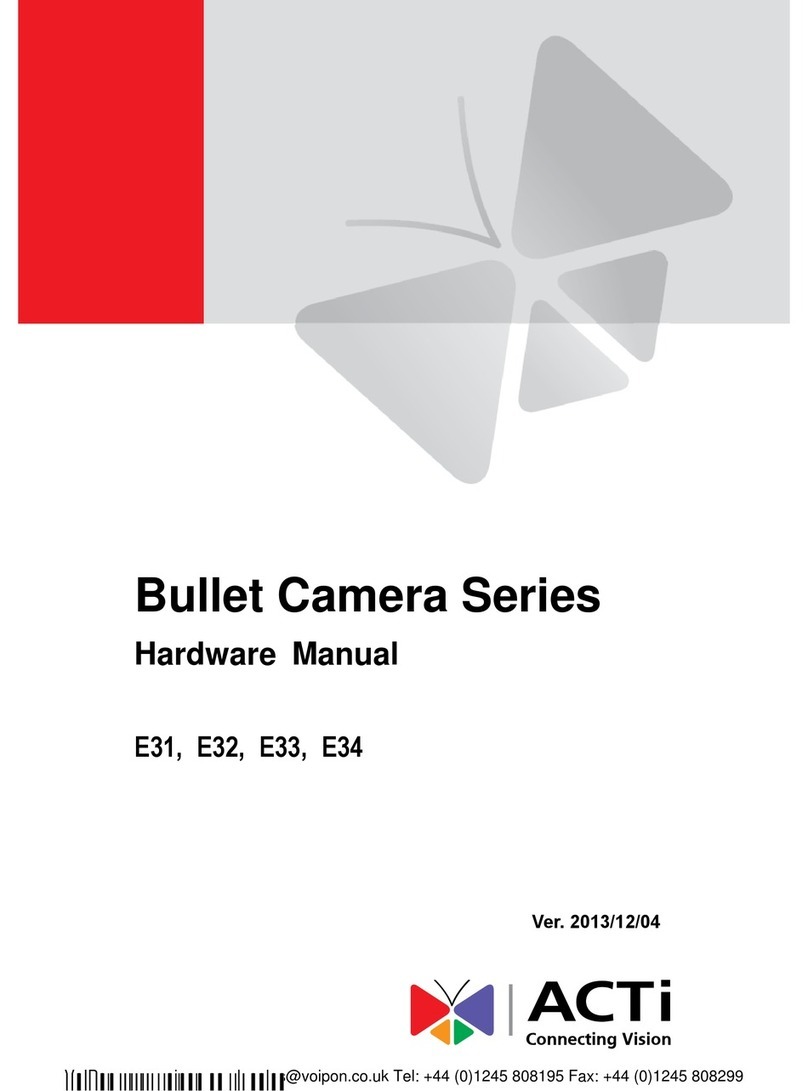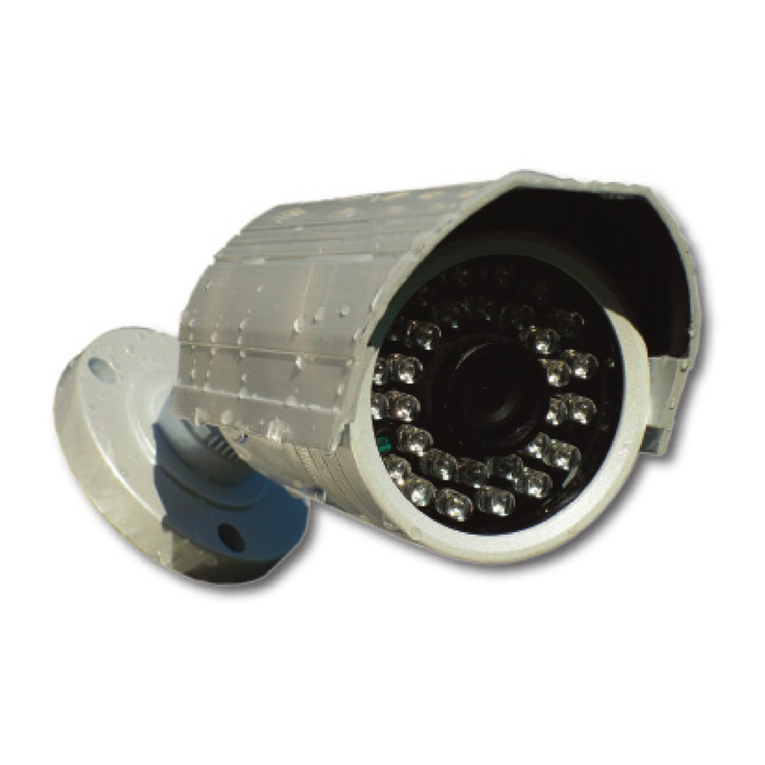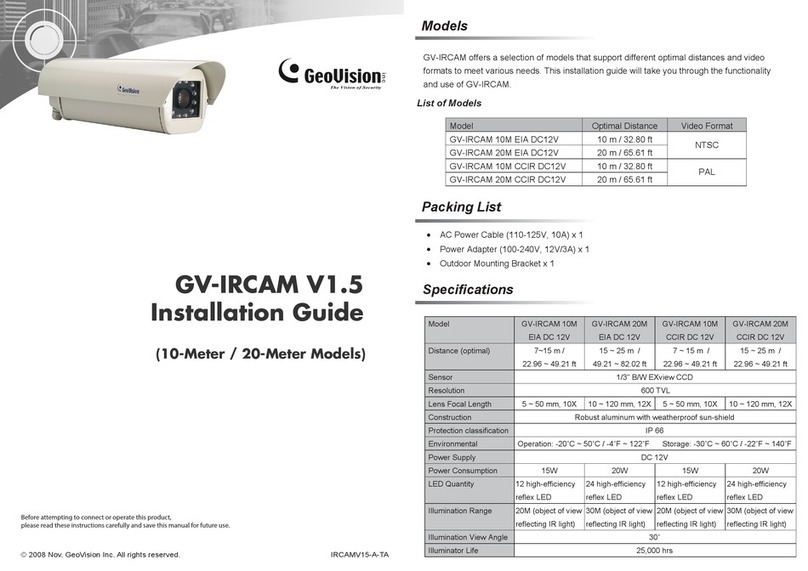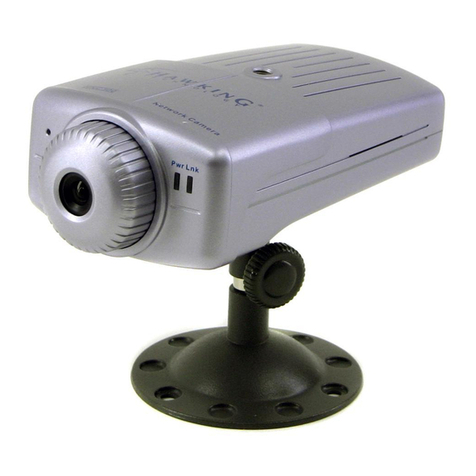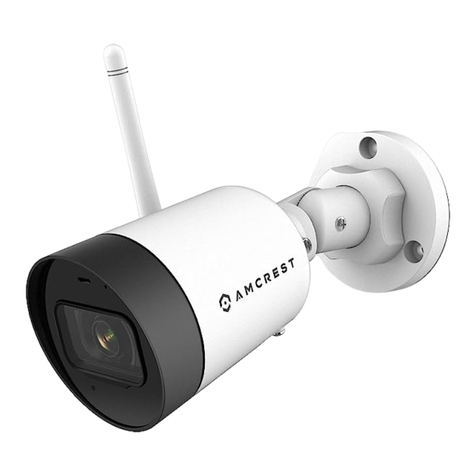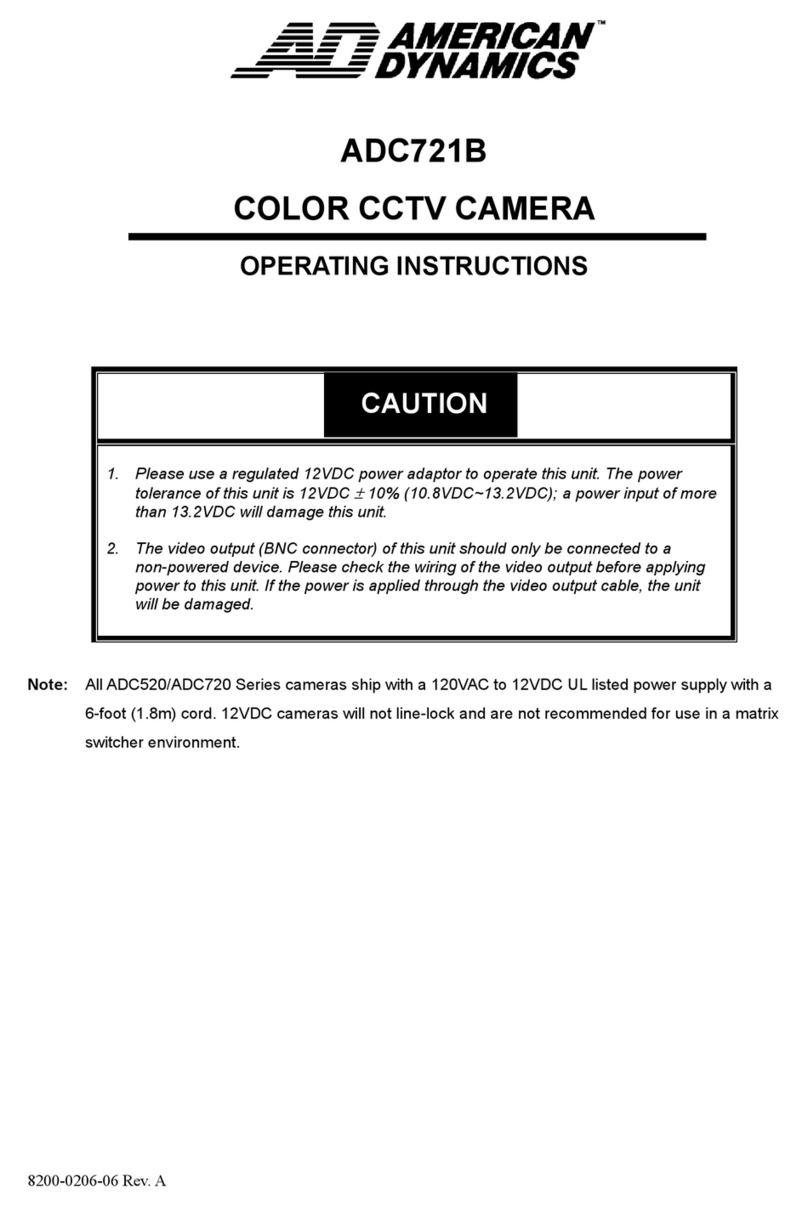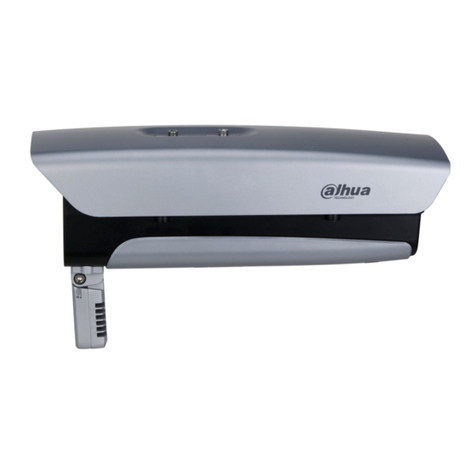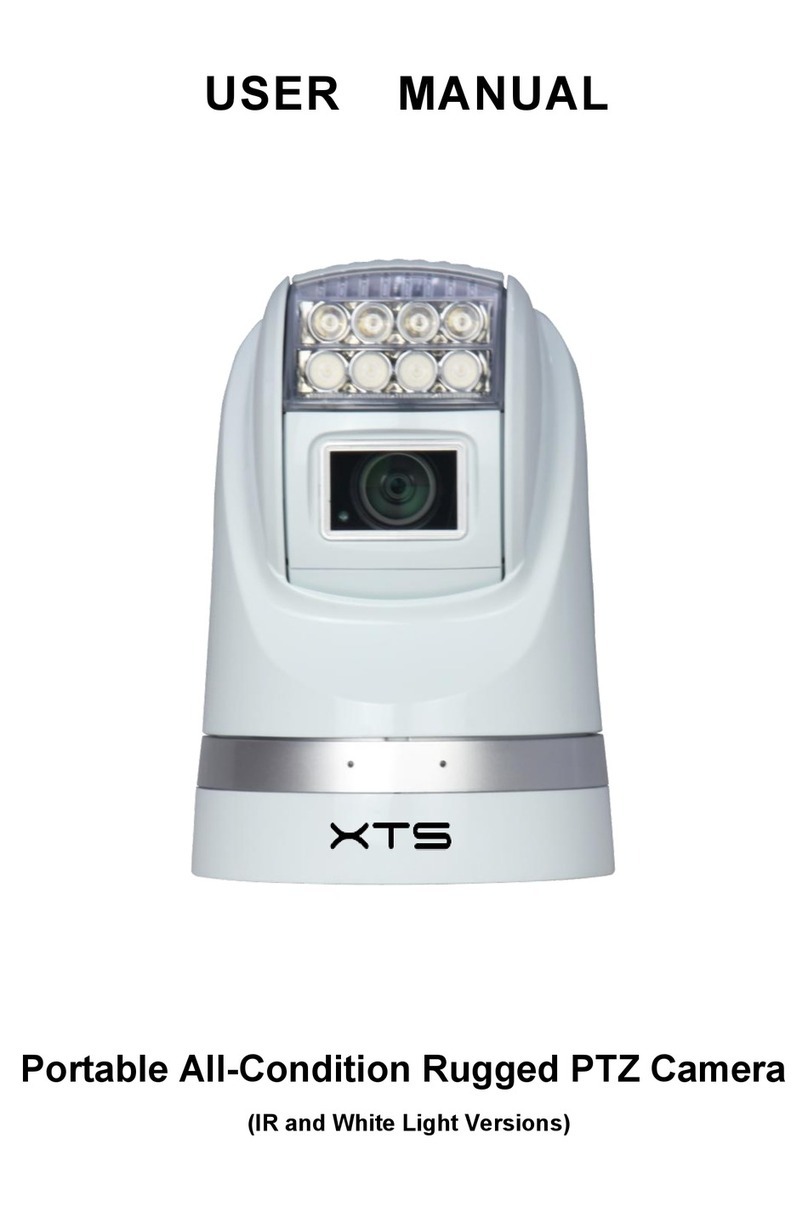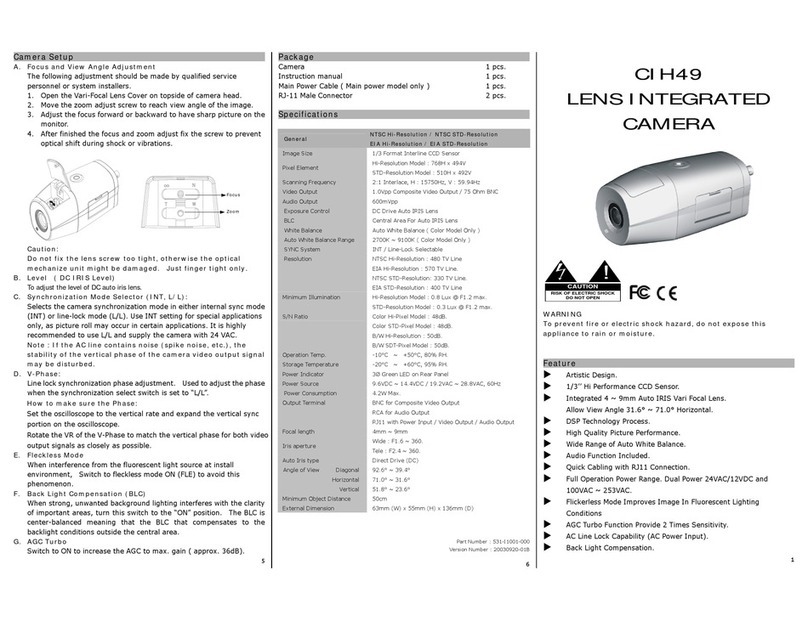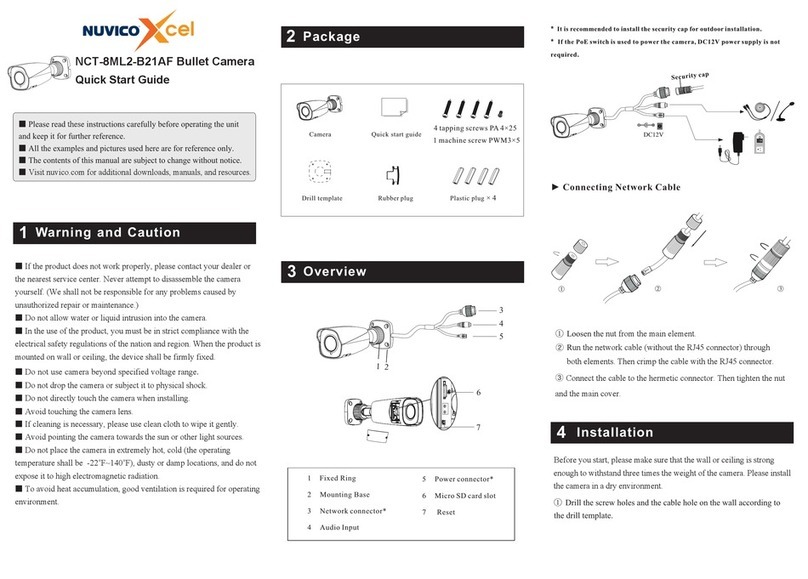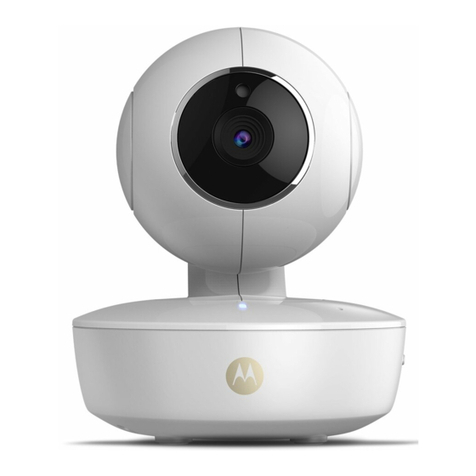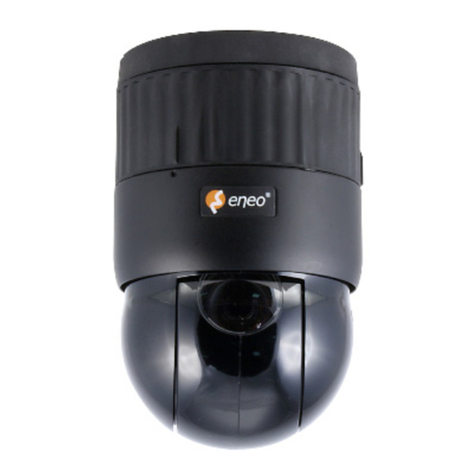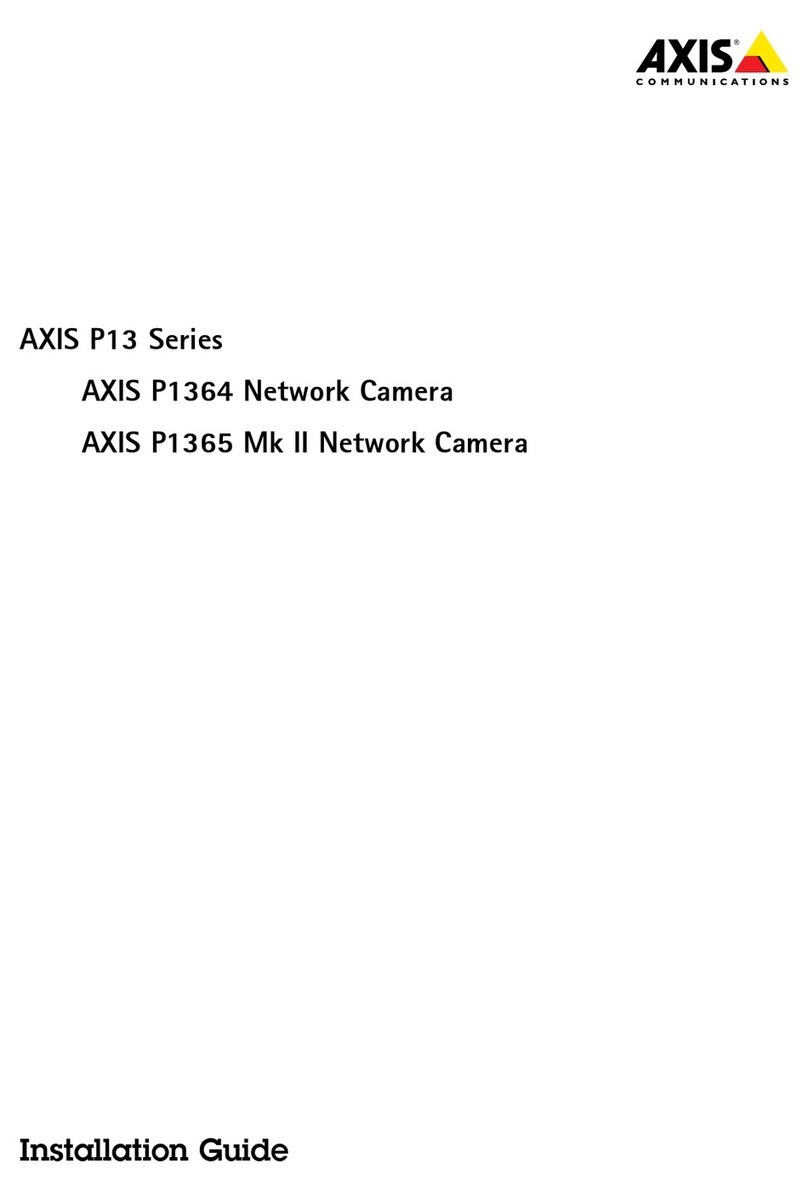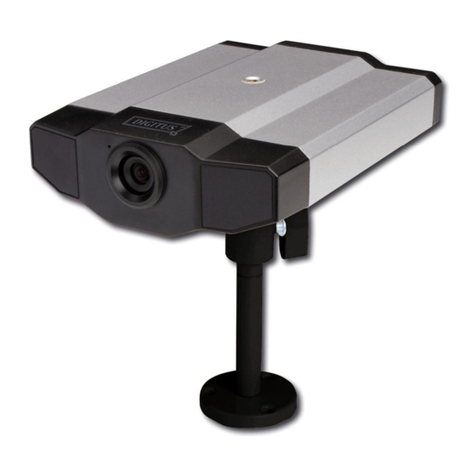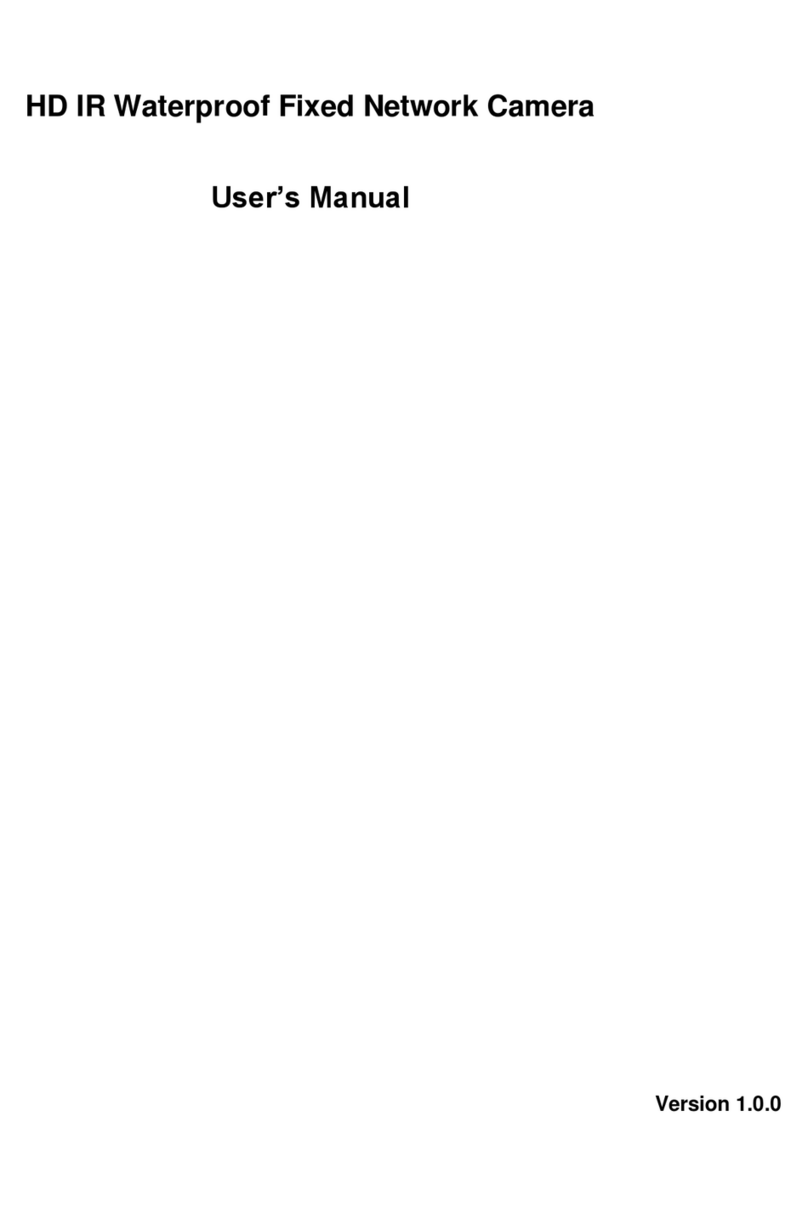DeView MD3CN12M User manual

RoHS
MD3 Series
Tamper Proof Internal Dome Camera
Quick Installation Guide
*US Patent Pening
Type / Format NTSC PAL
Scanning Element 2:1 Interlace, 2:1 Interlace,
H15.734KHz / V :59.9Hz H15.625KHz / V :50Hz
Image Picture Element 1/3” Interline CCD
Effective Picture Element 510(H) x 492(V) 500(H) x 582(V)
Resolution (TV lines) 330
Minimum Illumination 0.7 Lux @ F1.6
S/N Ratio
48dB
Back Light Compensation
Central Area for DC IRIS Lens
Exposure Control DC Type Auto IRIS Control
Sync System
INT
Gamma Compensation 0.45
Video Output 1.0Vpp, 75 ΩUnbalanced
White Balance
Automatic White Balance
Auto White Ballance Range
2500K – 9700K
Power Range* DC 12V ±10%
Power Consumption 1.6W (Max)
Operating Temperature
Storage Temperature
MD3CN12M MD3CP12M
-10°C ~ +50°C
-20°C ~ +60°C
NTSC PAL
2:1 Interlace, 2:1 Interlace,
H15.734KHz / V :59.9Hz H15.625KHz / V :50Hz
1/3” Interline CCD
768(H) x 494(V) 752(H) x 582(V)
480
1.2 Lux @ F1.6
48dB
Central Area for DC IRIS Lens
DC Type Auto IRIS Control
INT
0.45
1.0Vpp, 75 ΩUnbalanced
Automatic White Balance
2500K – 9700K
DC 12V ±10%
1.8W (Max)
MD3CN12H MD3CP12H
-10°C ~ +50°C
-20°C ~ +60°C
General Specification
Focal Length 4mm~9mm
F-No. F1.6
Iris Range F1.6~F2.4
Minimum Object Distance 4mm (71.3x48.3 cm) 9mm (28.3x20.8cm)
Field Of View
Diagonal 92.8º~39.4º
Horizontal 71.0º~31.6º
Vertical 51.6º~23.6º
Lens Specification
Funtion Control
Electronic Shutter
BLC
AGC-UP
Low Light Chroma Suppression
------
ON/OFF
ON/OFF
AUTO
Regulatory Compliance
Emissions FCC part 15 Class B
CE: EN55011
ICES-003
EN55022
CISPR 11
CISPR22
ANSI C63.4
Immunity CE: EN50130-4
RoHS
FCC COMPLIANCE:
This equipment has been tested and found to comply with the limits for a Class B digital device, pursuant to Part 15 of the
FCC Rules.These limits are designed to provide reasonable protection against armful interference in a residential installation.
This equipment generates uses and can radiate radio frequency energy and, if not installed and used in accordance with the
instructions, may cause harmful interference to radio communications. However, there is no guarantee that interference will
not occur in a particular installation.
If this equipment does cause harmful interference to radio or television reception, which can be determined by turning the
equipment off and on, the user is encouraged to try to correct the interference by one or more of the following measures:
• Reorient or relocate the receiving antenna.
• Increase the separation between the equipment and receiver.
• Connect the equipment into an outlet on a circuit different from that to which the receiver is connected.
• Consult the dealer or an experienced Radio/TV technician for help.
CISPR 22 WARNING:
This is a Class B product. In a domestic environment this product may cause radio interference in which case the user may be
required to take adequate measures.
POWER SUPPLY REQUIREMENTS:
For use with listed Audio/Video product and only connected to 15W or less power supply.
*Power supply should be a NEC Class 2 / LPS Supply.
EQUIPMENT MODIFICATION CAUTION:
Equipment changes or modifications not expressly approved by seller.
The party responsible for FCC compliance could void the user’s authority to operate the equipment and could create a
hazardous condition.
This class B digital apparatus complies with Canadian ICES-003.
Cet appareil numérique de la classe B est conforme à la norme NMB-003 du Canada.
Please visit our website for more information
www. deview.com
T1
T2
Side Knock-out
Side Knock-out
Side Knock-out
Side Knock-out
Template
Cable access
When the cables are threaded through the mounting surface,
create an apture indicated “T2”. It can be simply threaded for
use with the quick install adapter .
When mounting the dome on a surfce with the four T1 screws,
use one of the side knock-outs as indicated for cable entry
(see Installation Guide overleaf ).
Surface mount (In a wall or ceiling)
Using Quick Install Adaptor:
Create an aperture in the mounting surface to a diameter of
1.5” (38mm) as indicated by “T2”.
The aperture is also avaliable for cable access (3/4”, 19mm).
Using screws:
Create four holes at template positions ‘T1’, use the screws
and plugs provided in the screw kit where the mounting
surface is appropriate.
Cable Access
T1
T1
T1
A1 : Focus Adjuster
A2 :Field of View Adjuster
A1
A2
Camera Adjustments
A3 : Function Control Dip Switches
*A4 : AI Level Adjustment
*AI Level Adjustment is factory set.
Should not normally require adjustment
A3
A4
Hardware Kit Contents
• 1/2” Rubber Grommet
• 3/4” Rubber Grommet
• Screw Pack
• Torx Driver
• Optional Quick Install Adaptor
• Wire-ended Power Adaptor lead
Switch 2
ONOFF
Back Light Compensation
Auto Gain Control
OFF
(Normal Mode)
ON
(Turbo Mode)
Switch 1
Function Control Dip Switches
12VDCGND
Red : +12VDC
Black: 0 VDC
Connecting Video-Power Cables
Video Output
Power Input
Wire-ended Power Adaptor Lead
V531-DF000-240
Ver A.070615

Quick Install Adaptor
Dome Base
Camera Module
Camera Liner
Dome Cover
Locking Arms
Tighten tamper-proof screw
1
2
3
4
5
6
Installation
Preparation before installation
Use the template (see overleaf) to mark-out and prepare the mounting area.
In order to mount the base, first remove the camera module by gently pulling
down on the tabs that hold the camera module in place (see image right) and
remove camera assembly. To re-assemble gently pull down on the tabs and
insert the camera assembly.
Using the base mounting holes:
When mounting the dome to a ceiling or wall using screws, first knock out the
screw access holes that correspond to the template marks “T1”.This can be
done by using a cross-point screwdriver.
Push the cables through the dome base and 3/4” rubber grommet.
Install the grommet on the base to prevent dust ingress. Cables may be routed
through the mounting surface if an appropriate hole is made at location T2.
If using the side knock-out, make sure the video-power cables are properly
arranged in the cable notch and exit out of the side knock without being
crushed (see image A).
Using the Quick Install Adaptor(Optional):
When mounting the dome to a ceiling using the quick install adaptor, use the
template to cut a hole as the circle marked “T2” with a hole cutter.
Install the adaptor into the mounting surface and use the screws to adjust the
position of the two locking arms on the quick install adaptor to adjust to the
mounting surface.
Push the cables through the opening and 1/2” rubber grommet.
Make sure the grommet is properly installed on the adaptor to prevent dust
ingress (see image B).
Mount on a US Single Gang Box:
When mounting the dome to the box, carefully remove the screws on the
box.Install the 3/4“ grommet on the base to prevent dust ingress, then push
the cables through the dome base and 3/4” rubber grommet.
Mount the dome base on the box and reinstall the two screrws.
Tighten the screws sufficiently on the box (position T1, see image C).
Removing the dome cover and the camera liner
Gently turn the dome cover counter-clockwise to unlock and pull free of the
dome base. Remove the camera liner by gently pulling it free of the 4 notches
in the camera base (see image A).
Opening the required knock-out panel
Open one of the side knock-outs (see image A) to the size required to allow
cable entry.
Replace the dome cover
Replace the dome cover and rotate clockwise to close it (as shown in image 5).
Install the camera liner
Carefully fit the camera liner over the camera base so that it snaps into place
(as shown in image 4), and do not obstruct the camera lens.
Install camera module
Push the video-power cables through the opening
Feed the pre-connected video-power cables through the appropriate point.
Then push the cable out of the opening. Make sure the cable is positioned on
the proper location and out of the side knock-out, if required.
Adjust the camera position
You can adjust the camera position by rotating and panning the camera base
(see image 3).
The focus and range of the lens can be adjusted (depending on the lens, see
instructions overleaf).
Mount the dome enclosure
By using the base mounting holes, the dome base can be fixed on the wall or
ceiling with attached screws.
Note: When using Quick Install Adaptor, re-assemble the parts of dome, then
mount the whole dome onto adaptor (see image B).
Tighten the tamper-proof screw
Use the supplied torx driver and the tamper-proof screw (T2x5L) to secure the
dome cover (see image 6).
A.
B.
C.
1.
2.
3.
4.
5.
6.
Use the quick install adaptor on a wall or ceiling application.
ROTATE 360°
PAN 360°
TILT 90°
Tamper-proof Screw
Install the Dome Liner on the Camera Module
US Single Gang BoxDome Base
T1
T1
C.Mount on a pre-installed US Single Gang Box
3/4”
Rubber Grommet
Video-Power Cables
Mounting Surface
1/2”Rubber Grommet
B.Mount with the Quick Install Adaptor
Side
Knock-outs
Mounting Surface
A.Mount with the Dome Base
Cable Notch
Cable Notch
3/4”
Rubber Grommet
PULL
Loosen the tab and pull out the camera assembly
This manual suits for next models
3
Table of contents
Other DeView Security Camera manuals
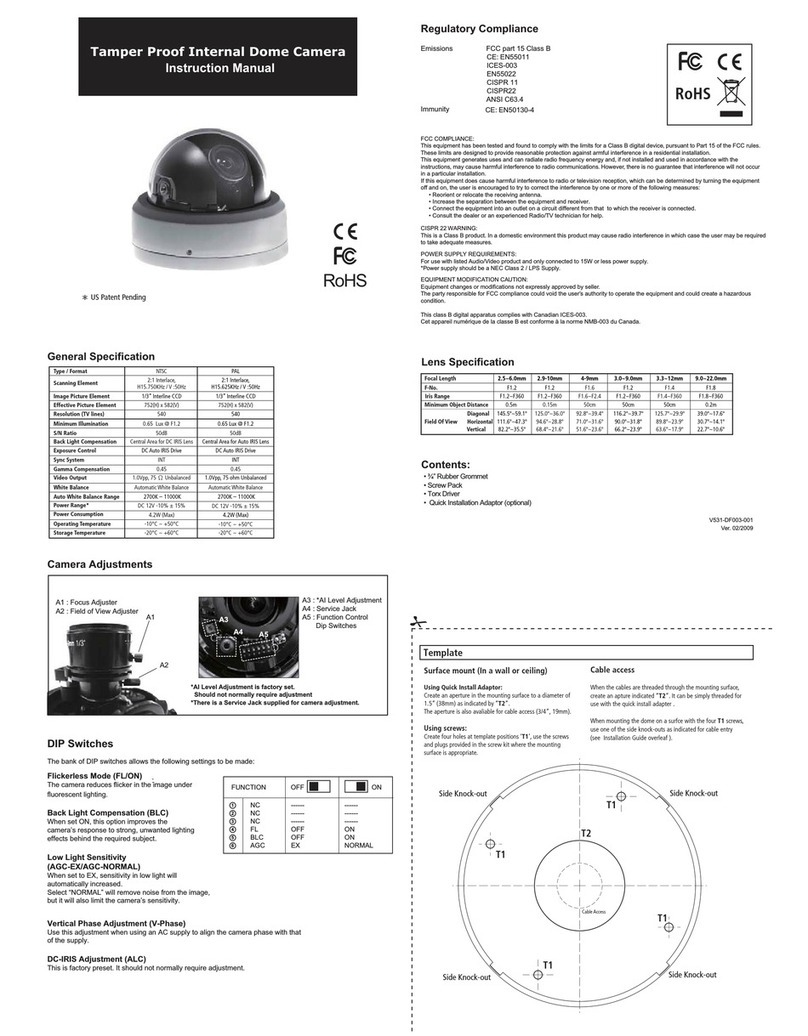
DeView
DeView Tamper Proof User manual
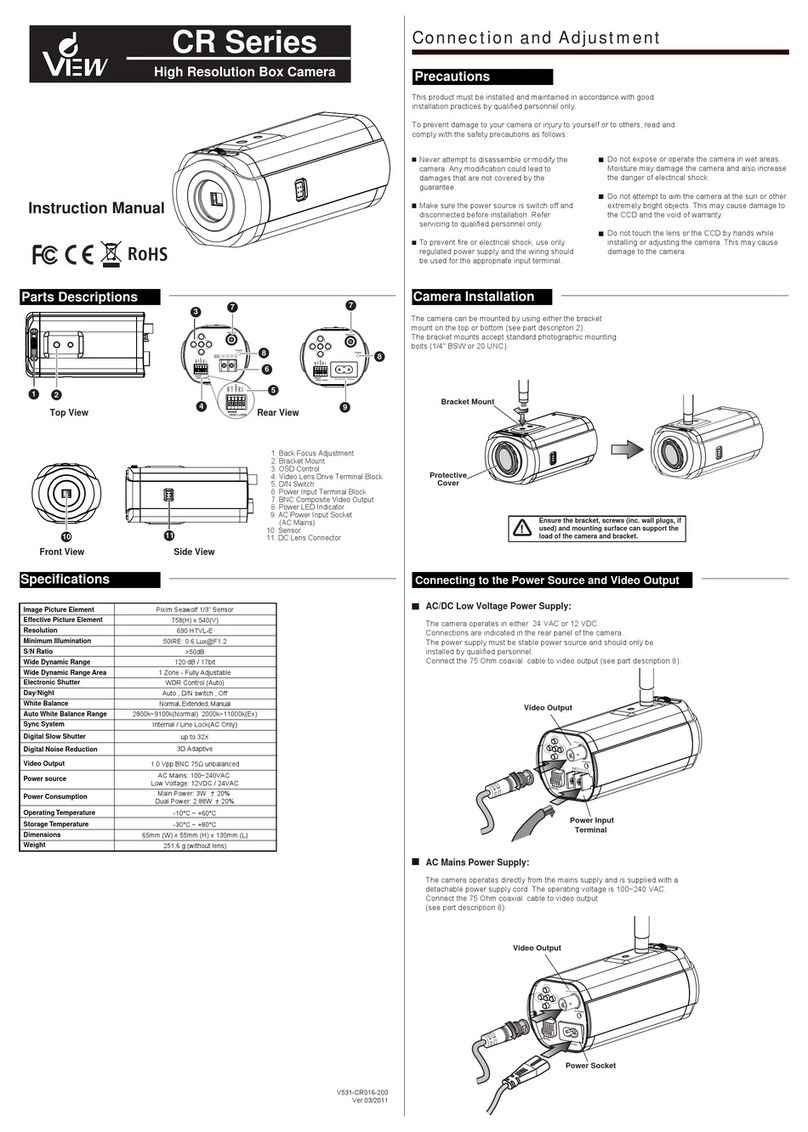
DeView
DeView CR Series User manual
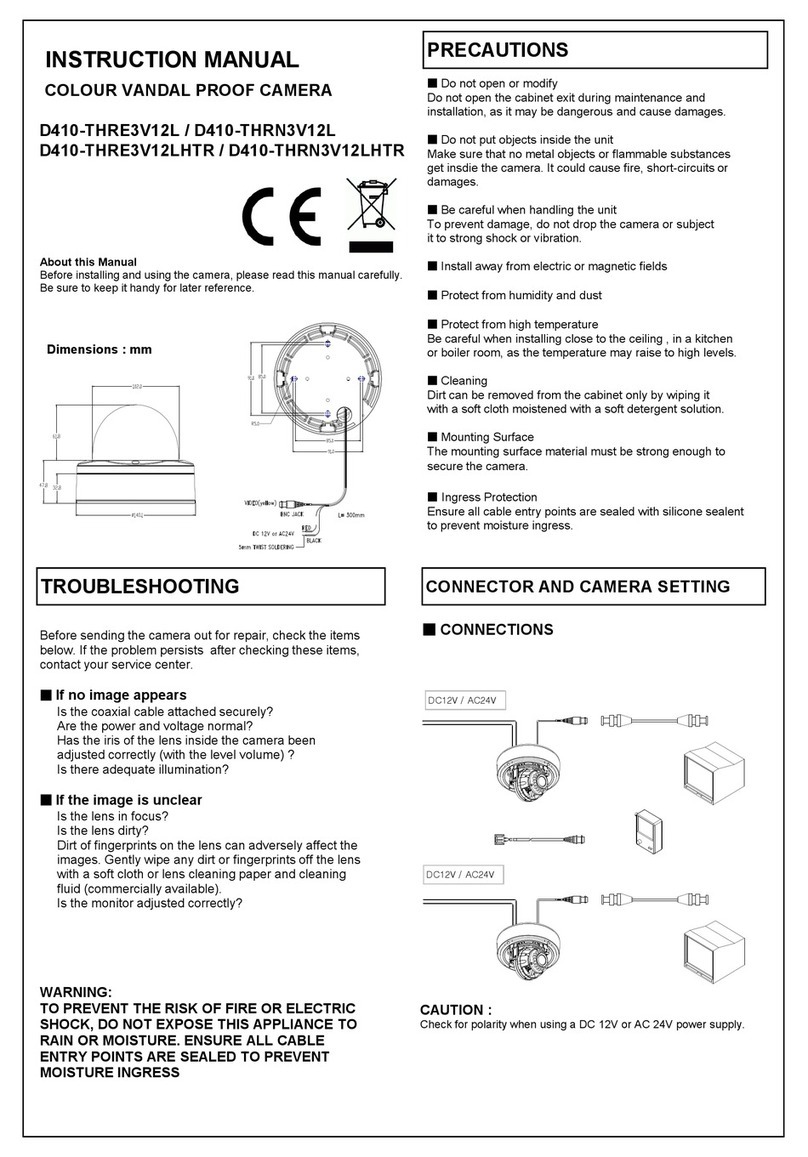
DeView
DeView D410-THRE3V12L User manual
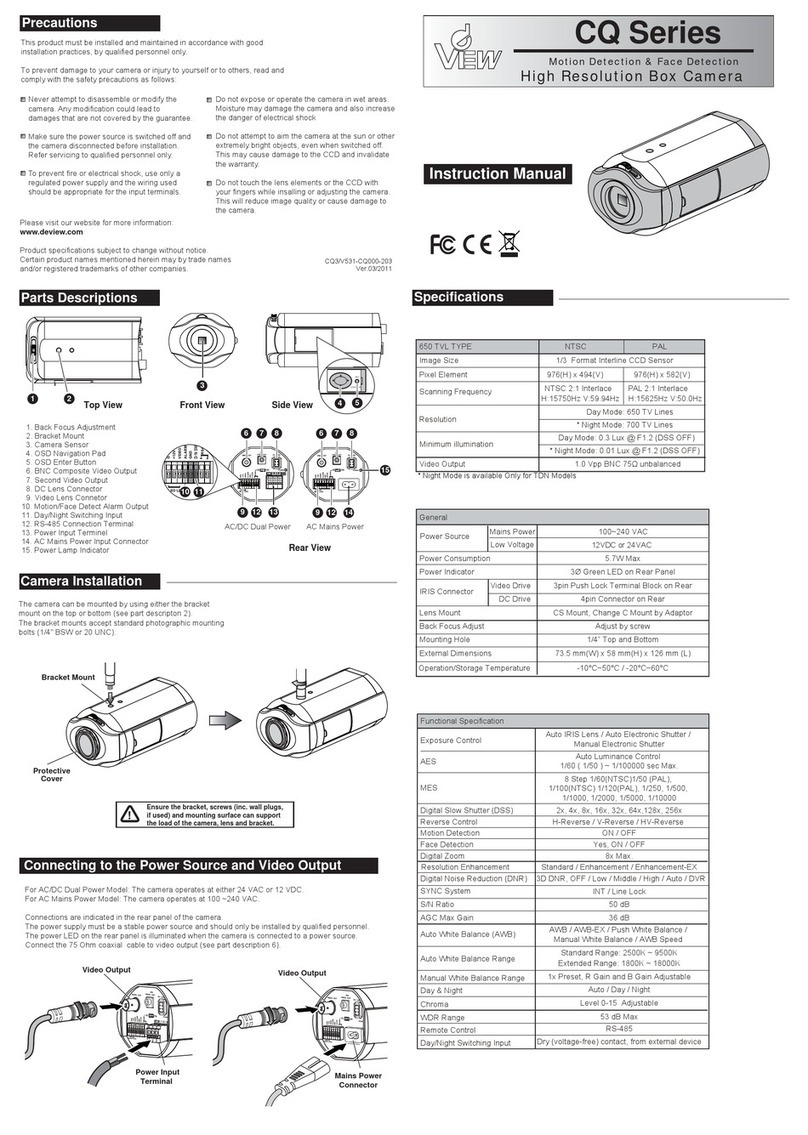
DeView
DeView CQ Series User manual
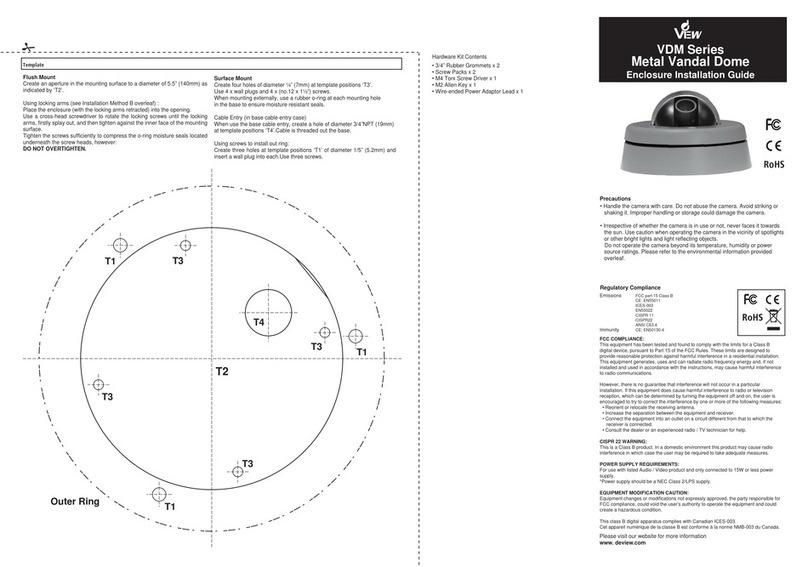
DeView
DeView VDM Series User manual
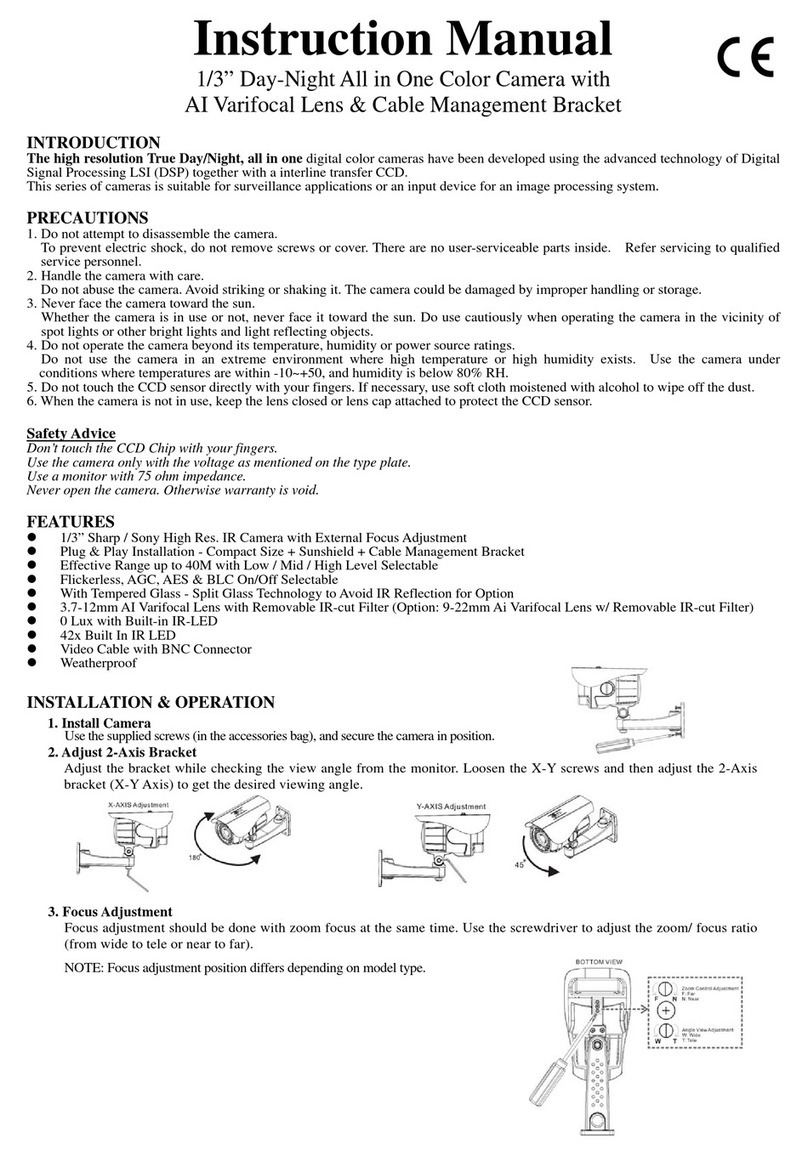
DeView
DeView BTP12H37V12L User manual

DeView
DeView CR Series User manual
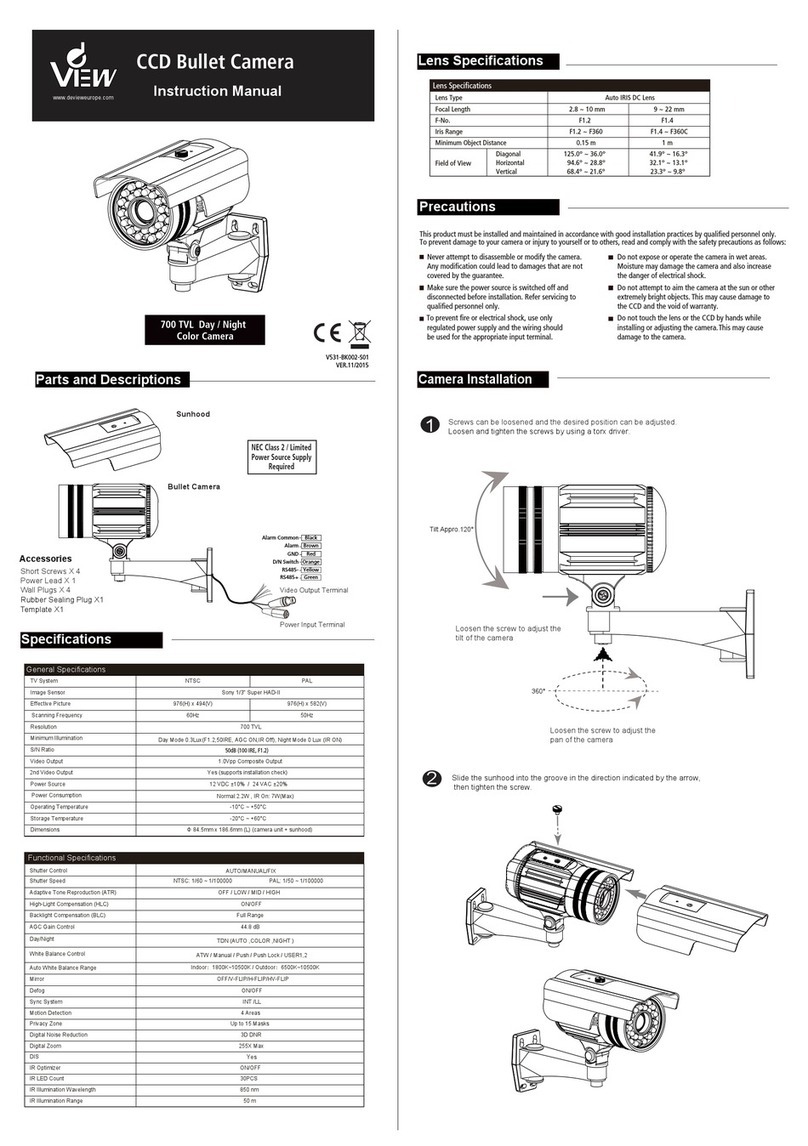
DeView
DeView CCD User manual

DeView
DeView CR Series User manual
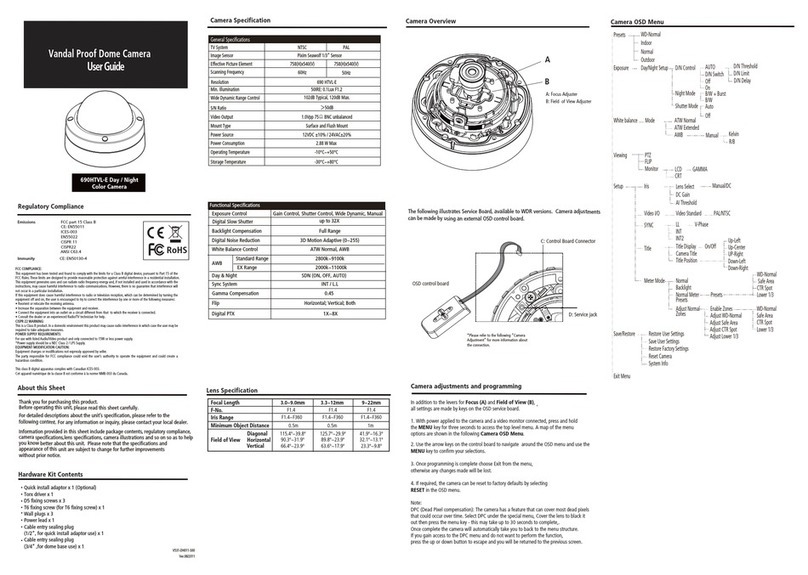
DeView
DeView 690HTVL-E User manual
